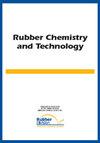DYNAMIC REVERSIBLE NETWORKS AND DEVELOPMENT OF SELF-HEALING RUBBERS: A CRITICAL REVIEW
IF 1.5
4区 工程技术
Q4 POLYMER SCIENCE
引用次数: 2
Abstract
An intensive literature search shows that research in the field of self-healing rubbers is still in its infancy. By analyzing the various reviews and reports available, most of the results prove to be complicated; however, a few studies show promising self-healing properties of new elastomers. Most of these materials were prepared by relatively sophisticated chemical syntheses. Many of the studies on self-healing materials also deal with commercial rubbers, but the mechanical performance of these self-healing systems is very poor for practical application, perhaps because self-healing systems are usually prepared with an uncured or pseudo-crosslinked matrix structure. The poor mechanical properties are related to the highly viscous but inelastic nature of the uncured or only partially cured rubber compound. Importantly, most of the studies have been conducted on rubber systems without reinforcing fillers. For filler-reinforced rubber systems, the question is whether the working principle of reversible bonds is applicable. This literature review attempted to compile the current promising self-healing systems, describe their underlying chemical mechanisms, and discuss the self-healing concept from a thermodynamic perspective. In addition, this review is focused on the critical discussion of the principle and origin of self-healing behavior and finally draws conclusions on the applications and opportunities for further developments in this field.动态可逆网络和自愈橡胶的发展:综述
一项深入的文献研究表明,自修复橡胶领域的研究仍处于起步阶段。通过分析各种可用的评论和报告,大多数结果证明是复杂的;然而,一些研究表明,新型弹性体具有良好的自修复性能。这些材料大多是通过相对复杂的化学合成制备的。许多关于自修复材料的研究也涉及到商业橡胶,但是这些自修复系统的机械性能对于实际应用来说非常差,可能是因为自修复系统通常是用未固化或伪交联的基质结构制备的。其较差的力学性能与未固化或部分固化胶料的高粘性和无弹性有关。重要的是,大多数研究都是在没有增强填料的橡胶体系上进行的。对于填料增强橡胶体系,问题是可逆键的工作原理是否适用。本文综述了目前有前途的自愈系统,描述了它们潜在的化学机制,并从热力学的角度讨论了自愈概念。此外,本文还对自愈行为的原理和起源进行了批判性的讨论,并对该领域的应用和进一步发展的机会进行了总结。
本文章由计算机程序翻译,如有差异,请以英文原文为准。
求助全文
约1分钟内获得全文
求助全文
来源期刊

Rubber Chemistry and Technology
工程技术-高分子科学
CiteScore
3.50
自引率
20.00%
发文量
21
审稿时长
3.6 months
期刊介绍:
The scope of RC&T covers:
-Chemistry and Properties-
Mechanics-
Materials Science-
Nanocomposites-
Biotechnology-
Rubber Recycling-
Green Technology-
Characterization and Simulation.
Published continuously since 1928, the journal provides the deepest archive of published research in the field. Rubber Chemistry & Technology is read by scientists and engineers in academia, industry and government.
 求助内容:
求助内容: 应助结果提醒方式:
应助结果提醒方式:


